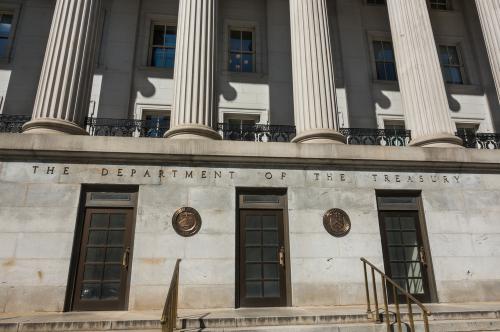There is widespread, though not universal, agreement among those who led the response to the global financial crisis of 2007-09 that the panoply of reforms enacted over the past few years has made the U.S. financial system safer.
Daniel Tarullo, who was appointed to the Federal Reserve Board by President Obama in 2009 and leads the Fed’s oversight of the banking system, joins the consensus. The financial system “feels obviously and substantially safer than a decade ago,” he said at an event hosted by the Hutchins Center on Fiscal and Monetary Policy at Brookings.
But, he added, “Safer does not necessarily mean safe enough.”
“The moment when you tell yourself: ‘Hey, we’re safe enough’ is when the problems are going to start to arise,” he said. This doesn’t imply the U.S. perpetually needs more regulation. Rather, he said, it calls for “supple analytic and institutional mechanisms” that are better at responding to the adaptation and innovation of financial markets.”
Tarullo noted that there were two major weaknesses in the pre-crisis U.S. financial system: Banks that were too-big-too-fail and thus had to be rescued by the government and the “size and fragility of the so-called shadow banking system,” a label which applies to a wide range of financial institutions but excludes the highly regulated banks. (Tarullo used the term “shadow banking” with some distaste because he believes it both includes firms that don’t pose threats and isn’t expansive enough to include all the firms that do.)
The risks posed by both have diminished, Tarullo argued. In the case of too-big-to-fail, regulation and higher capital requirements have made a big difference. In the case of shadow banking, some nonbank financial entities have been “brought within the bounds of prudential regulation,” but the risks mostly diminished because several sectors were hard hit in the crisis and fell out of favor. (Some academics, such as Anil Kashyap of the University of Chicago, think that the regulation he’s referring to—Dodd-Frank—got it wrong by putting too-big-to-fail front and center instead of shadow banking.)
Though the “shadow banking sector is smaller and the traditional banking sector is more resilient,” Tarullo voiced several concerns. First, he wanted to make sure regulators do not apply blanket restrictions to non-bank financial intermediaries without respect to the differing risks they pose. (He was not concerned that pension funds will cause stability problems, for example.)
This involves discriminating between types of firms, but also by activity within types. “For example, some classes of asset managers, such as bond funds that hold relatively illiquid assets while offering their investors the right to withdraw funds on very short notice, may pose redemption risks. But intermediaries such as many conventional mutual funds do not pose bank-like risks, since they generally are not leveraged.” As such, “the optimal regulatory response would surely not be one that treats all asset managers as quasi-banks that need to have capital and similar bank regulatory constraints.”
Second, he wanted regulators to remain aware of how the financial landscape is changing and rely on less rigid and more “effective and supple mechanisms” for meeting those changes.
And third, he wanted wholesale funding markets—which have decreased in size since the crisis, but remain large—to be safer. “If there is one lesson to be drawn from the financial crisis, it is that the rapid withdrawal of funding by short-term credit providers can lead to systemic problems as consequential as those associated with classic runs on traditional banks,” he said.
For video footage of the conversation with Governor Tarullo, and the perspectives of Ben Bernanke, Gary Gorton, Betsy Graseck, Darriell Duffie, Victoria Ivashina, Nellie Lang, and Anil Kashyap, click here.
The Brookings Institution is committed to quality, independence, and impact.
We are supported by a diverse array of funders. In line with our values and policies, each Brookings publication represents the sole views of its author(s).


Commentary
Fed’s Tarullo on financial stability: We’re safer, but are we safe enough?
November 19, 2015